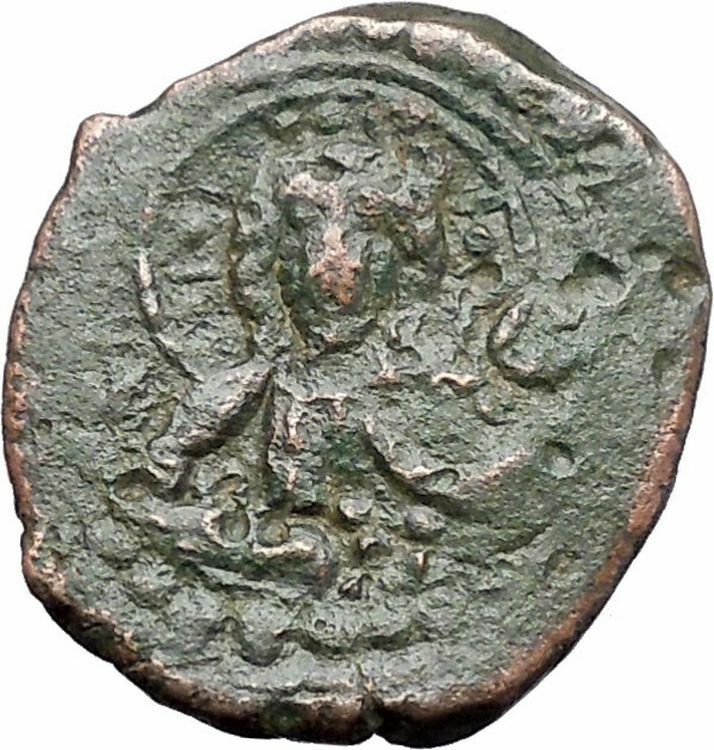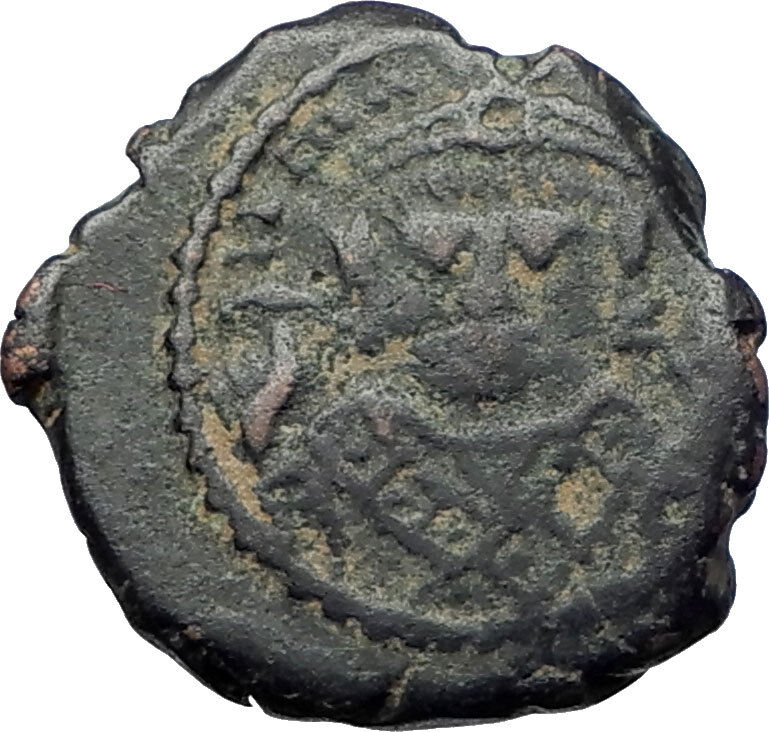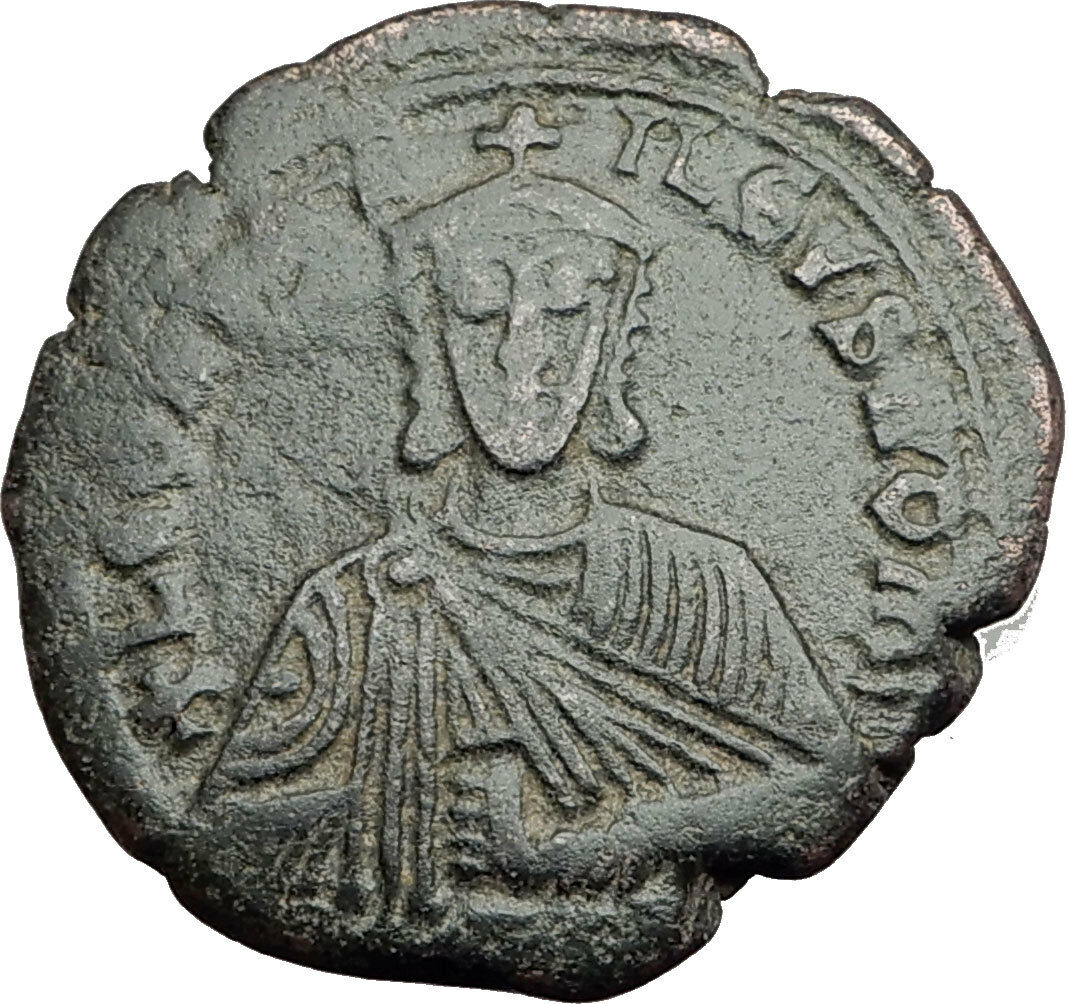|
Byzantine Empiere
Romanus I, Lecapenus – Emperor: 920-944 A.D.
Bronze Follis 22mm (3.74 grams) Constantinople mint: 920-944 A.D.
Reference: Sear 1760
+RWmAn’ bASILЄVS Rwm’ – Facing bust of Romanus I, bearded, wearing crown
and jeweled chlamys,
and holding labarum, transversely, and globe cross.
+RwmA / n’ Єn ΘЄW bA / SILЄVS RW / mAIWn in four lines.
You are bidding on the exact item pictured,
provided with a Certificate of Authenticity and Lifetime Guarantee of
Authenticity.
Romanos I Lekapenos (or Romanus I Lecapenus) (circa 870 – June
15, 948) was
Byzantine Emperor
from 920 until his deposition
on December 16, 944.
Origin
Romanos was the son of an imperial guardsman named Theophylaktos Abstartos or
Abastaktos (“the Unbearable”). Although he did not receive any refined education
(for which he was later abused by his son-in-law Constantine VII), Romanos
advanced through the ranks of the army during the reign of Emperor
Leo VI the Wise
. In 911 he was general of the
naval theme of
Samos
and later served as admiral of the fleet
(droungarios
tou ploimou). In this capacity he was supposed to participate in
the Byzantine operations against
Bulgaria
on the
Danube
in 917, but he was unable to carry out
his mission. In the aftermath of the disastrous Byzantine defeat at the
Battle of Acheloos
in 917 by the Bulgarians,
Romanos sailed to
Constantinople
, where he gradually overcame the
discredited regency of Empress
Zoe Karvounopsina
and her supporter
Leo Phokas
.
Rise
to power
Becoming increasingly influential at court, Romanos exiled his rivals and
strengthened his links with the underage Emperor
Constantine VII
. In May 919 he married his
daughter
Helena Lekapene
to Constantine and was
proclaimed
basileopator
(“father of the emperor”). On
September 14, 920, Romanos was invested as kaisar (Caesar),
and finally on December 17 of the same year he was crowned co-emperor, becoming
the effective head of the
Byzantine Empire
.
In subsequent years Romanos crowned his own sons co-emperors,
Christopher
in 921,
Stephen
and
Constantine
in 924, although, for the time
being, Constantine VII was regarded as first in rank after Romanos himself. It
is notable that, as he left Constantine untouched, he was called ‘the gentle
usurper’. Romanos strengthened his position by marrying his daughters to members
of the powerful aristocratic families of Argyros and Mouseles, by recalling the
deposed patriarch
Nicholas Mystikos
, and by putting an end to the
conflict with the
Papacy
over the four marriages of Emperor Leo
VI.
War
and peace with Bulgaria
The first major challenge faced by the new emperor was the war with Bulgaria,
which had been re-ignited by the regency of Zoe. Romanos’ rise to power had cut
off
Simeon I of Bulgaria
‘s plans for a marital
alliance with Constantine VII, and Romanos was determined to deny the unpopular
concession of imperial recognition to Simeon, which had already toppled two
imperial governments. Consequently, the first four years of Romanos’ reign were
spent in warfare against Bulgaria. Although Simeon generally had the upper hand,
he was unable to gain a decisive advantage because of the impregnability of
Constantinople’s walls. In 924, when Simeon had once again blockaded the capital
by land, Romanos succeeded in opening negotiations. Meeting Simeon in person at
Kosmidion
, Romanos criticized Simeon’s
disregard for tradition and Orthodox Christian brotherhood and supposedly shamed
him into coming to terms and lifting the siege. In reality, this was
accomplished by Romanos’ tacit recognition of Simeon as emperor of Bulgaria.
Relations were subsequently marred by continued wrangling over titles (Simeon
called himself emperor of the Romans as well), but peace had been
effectively established.
On the death of Simeon in May 927, Bulgaria’s new emperor
Peter I
made a show of force by invading
Byzantine Thrace
, but showed himself ready to negotiate
for a more permanent peace. Romanos seized the occasion and proposed a marriage
alliance between the imperial houses of Byzantium and Bulgaria, at the same time
renewing the Serbian-Byzantine alliance with
Časlav of Serbia
returning independence the
same year. In September 927 Peter arrived before Constantinople and married
Maria
(renamed Eirene, “Peace”), the daughter
of his eldest son and co-emperor Christopher, and thus Romanos’ granddaughter.
On this occasion Christopher received precedence in rank over his brother-in-law
Constantine VII, something which compounded the latter’s resentment towards the
Lekapenoi, the Bulgarians, and imperial marriages to outsiders (as documented in
his composition
De Administrando Imperio
). From this point
on, Romanos’ government was free from direct military confrontation with
Bulgaria. Although Byzantium would tacitly support a
Serbian
revolt against Bulgaria in 931, and the
Bulgarians would allow
Magyar
raids across their territory into
Byzantine possessions, Byzantium and Bulgaria remained at peace for 40 years,
until
Sviatoslav’s invasion of Bulgaria
.
Campaigns
in the East
Romanos appointed the brilliant general
John Kourkouas
commander of the field armies (domestikos
ton scholon) in the East. John Kourkouas subdued a rebellion in
the theme of Chaldia
and intervened in Armenia in 924. From
926 Kourkouas campaigned across the eastern frontier against the
Abbasids
and their vassals, and won an
important victory at Melitene in 934. The capture of this city is often
considered the first major Byzantine territorial recovery from the Muslims.

The Byzantine fleet under Theophanes repels the Rus’ in 941.
Miniature from the
Madrid Skylitzes
.
In 941, while most of the army under Kourkouas was absent in the East, a
fleet of 15 old ships under the
protovestiarios
Theophanes
had to defend Constantinople from a
Kievan
raid. The invaders
were defeated
at sea, through the use of
Greek fire
, and again at land, when they landed
in Bithynia
, by the returning army under Kourkouas.
In 944 Romanos
concluded a treaty
with Prince
Igor of Kiev
. This crisis having passed,
Kourkouas was free to return to the eastern frontier.
In 943 Kourkouas invaded northern
Mesopotamia
and besieged the important city of
Edessa
in 944. As the price for his withdrawal,
Kourkouas obtained one of Byzantium’s most prised relics, the
mandylion
, the holy towel allegedly sent by
Jesus
Christ
to King
Abgar V of Edessa
. John Kourkouas, although
considered by some of his contemporaries “a second
Trajan
or
Belisarius
,” was dismissed after the fall of
the Lekapenoi in 945. Nevertheless, his campaigns in the East paved the way for
the even more dramatic reconquests in the middle and the second half of the 10th
century.
Internal
policies

The palace church at
Myrelaion
, commissioned by Romanos
I as a family shrine in 922.
Romanos I Lekapenos attempted to strengthen the Byzantine Empire by seeking
peace everywhere where that was possible. His dealings with Bulgaria and Kievan
Rus’ have been described above. To protect Byzantine Thrace from Magyar
incursions (such as the ones in 934 and 943), Romanos paid them protection money
and pursued diplomatic venues.
The Khazars
were the allies of the Byzantines until
the reign of Romanos, when he started persecuting the
Jews
of the empire. According to the
Schechter Letter
, the Khazar ruler
Joseph
responded to the persecution of Jews by
“doing away with many
Christians
” and Romanos retaliated by inciting
Oleg of Novgorod
(called Helgu in the
letter) against Khazaria.
Similarly, he had re-established peace within the church and overcome the new
conflict between
Rome
and Constantinople by promulgating the
Tomos of Union in 920. In 933 Romanos took advantage of a vacancy on the
patriarchal throne to name his young son
Theophylaktos
patriarch of Constantinople
. The new patriarch
did not achieve renown for his piety and spirituality, but added theatrical
elements to the Byzantine liturgy and was an avid horse-breeder, allegedly
leaving mass to tend to one of his favorite mares when she was giving birth.
Romanos was active as a legislator, promulgating a series of laws to protect
small landowners from being swallowed up by the estates of the nobility (dynatoi).
The legislative reform may have been partly inspired by hardship caused by the
famine of 927 and the subsequent semi-popular revolt of Basil the Copperhand.
The emperor also managed to increase the taxes levied on the aristocracy and
established the state on a more secure financial footing. Romanos was also able
to effectively subdue revolts in several provinces of the empire, most notably
in Chaldia, the
Peloponnese
, and
Southern Italy
.
In Constantinople, he built his palace in the place called
Myrelaion
, near the
Sea of Marmara
. Beside it he built a
shrine
which became the first example of a
private burial church of a Byzantine emperor.
End
of the reign
Romanos’ later reign was marked by the old emperor’s heightened interest in
divine judgment and his increasing sense of guilt for his role in the usurpation
of the throne from Constantine VII. On the death of Christopher, by far his most
competent son, in 931, Romanos did not advance his younger sons in precedence
over Constantine VII. Fearing that Romanos would allow Constantine VII to
succeed him instead of them, his younger sons Stephen and Constantine arrested
their father in December 944, carried him off to the
Prince’s Islands
and compelled him to become a
monk. When they threatened the position of Constantine VII, however,
the people of Constantinople revolted, and Stephen and Constantine were likewise
stripped of their imperial rank and sent into exile to their father. Romanos
died in June 948, and was buried as the other members of his family in the
church of Myrelaion. Having lived long under constant threat of deposition -or
worse- by the Lekapenoi family,
Constantine VII
was extremely resentful of
them. In his
De Administrando Imperio
manual written for
his son and successor,
Romanus II
, he minces no words about his late
father-in-law: “the lord Romanus the Emperor was an idiot and an illiterate man,
neither bred in the high imperial manner, nor following Roman custom from the
beginning, nor of imperial or noble descent, and therefore the more rude and
authoritarian in doing most things … for his beliefs were uncouth, obstinate,
ignorant of what is good, and unwilling to adhere to what is right and proper.”
Family
By his marriage to
Theodora
(who died in 922), Romanos had six
children, including:
-
Christopher Lekapenos
, co-emperor from 921
to 931, who was married to the Augusta Sophia and was the father of
Maria (renamed
Eirene
), who married Emperor
Peter I of Bulgaria
; Christopher’s son
Michael Lekapenos may have been associated as co-emperor by his grandfather.
-
Stephen Lekapenos
, co-emperor from 924 to
945, died 967.
-
Constantine Lekapenos
, co-emperor from 924
to 945, died 946.
-
Theophylaktos Lekapenos
, patriarch of
Constantinople from 933 to 956.
-
Helena Lekapene
, who married Emperor
Constantine VII
.
- Agatha Lekapene, who married Romanos Argyros; their grandson was Emperor
Romanos III
.
Romanos also had an illegitimate son, the eunuch
Basil
, who remained influential at court,
particularly during the period 976–985.
|










